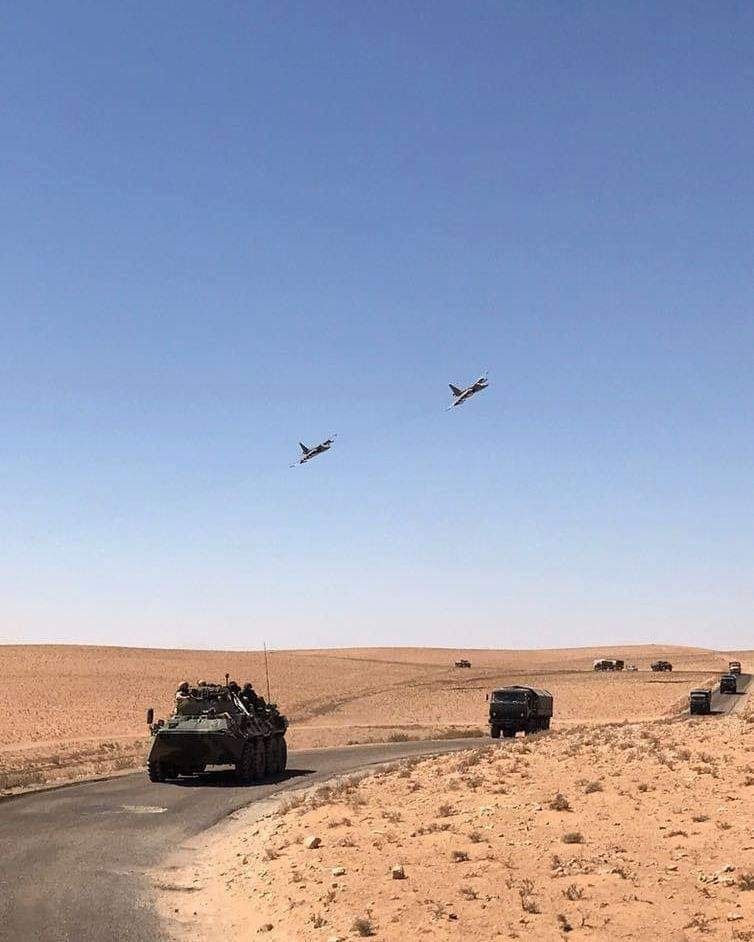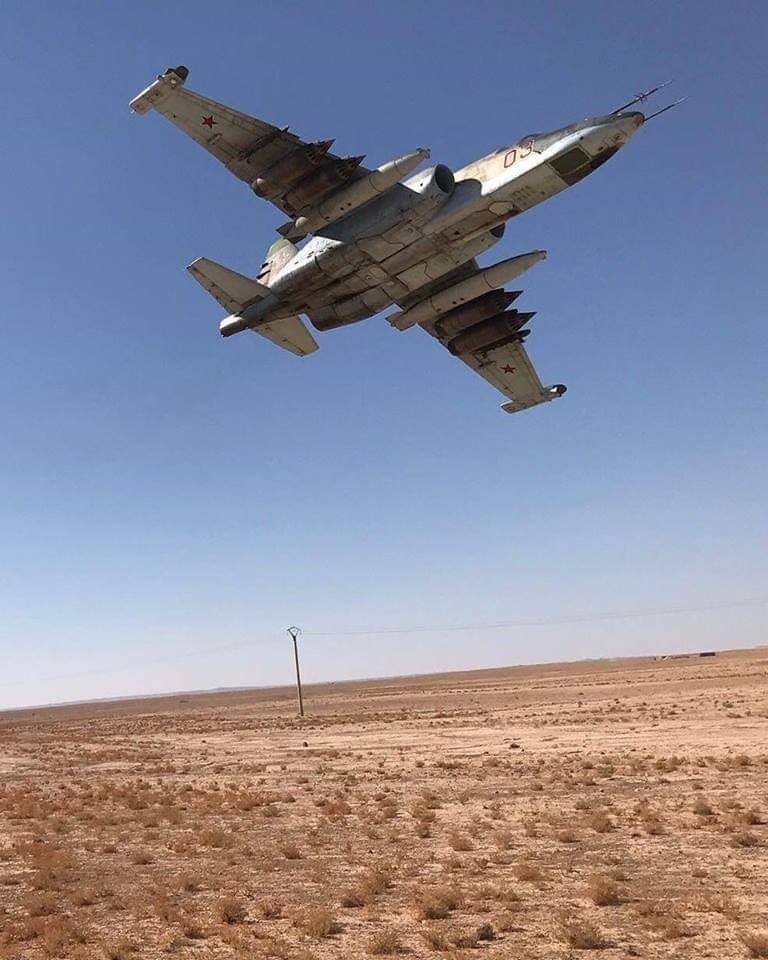Flashback.
It looks like a scene out of Afghanistan in the 1980’s when the Soviet were there, with a road convoy protected by low flying Frogfoot on overwatch. But those pictures were captured in Syria in 2017!
The Frogfoot can embark a fair amount of weaponry, but for an air support role such as this one, it relies on its canon and rocket pods. The Su-25 canon is the Gryazev-Shipunov GSh-30-2 30mm auto-cannon, which can fire up to 3,000 rounds per minutes. If this is not enough, an additional two 23mm cannon pods can be mounted under its wings.

In September the 18th 2017, Al Qaeda affiliated militias launched an offensive that penetrated 12Km into Syrian Army controlled territory, along the frontline between the Hama and Idlib provinces.
In the process, they managed to surround 29 Russian military police officers that were holding a checkpoint alongside a handful of SAA soldiers. The Russian MPs called in for help and a team of 15 Russian SF managed to get through to them before the Hayat Tahrir al-Sham militants managed to close the trap. They then proceeded to try and storm the checkpoint with APCs and tanks.
While the Russian commander at the Hmeimim base was trying to assemble Russian, NDF and SAA troops to try and breakthrough to the surrounded group of Russian and Syrian soldiers, a couple of planes were scrambled to provide the besieged Russians with fire support. The Russian commander had a variety of platforms, some of them fairly high tech, to chose from. But he needed something that could go low and slow, take a hit or two, dish out some punishment of its own and loiter over the area for a while if needed. He sent in two Su-25s.
In the end, those Frogfoots not only managed to hold the militants at bay but also helped blast a way through enemy lines for the little group to break out onboard Typhoon MRAPs and escape toward friendly positions. Once again, the tough old Frogfoot had shown Moscow just how irreplaceable it was.
The Su-25 was first tested and subsequently operationally deployed in Afghanistan in the summer of 1981. There, individual Frogfoot flew on average 360 missions a year! In 8 years of operations in Afghanistan, Soviet Frogfoot clocked in 60,000 sorties and only sustained 23 losses, including 9 on the ground.

In 1994, as the first Chechen war erupted, Su-25 were almost single-handedly responsible for the destruction of the Chechen air force on the ground in the opening hours of the conflict. The Su-25 subsequently took on both the CAS and strike aircraft role in the second Chechen war and the Russo Georgian war.
But it is in Syria, 34 years after first having entered service, that the Frogfoot demonstrated once again how important it was to the Russian Air Force: In the first 5.5 months of Russian operations in Syria, the RuAF flew over 9,000 sorties. That is an average of 50 to 65 sorties a day for the 32 planes initially deployed at Hmeimim. The majority of those sorties were initially flown by Su-24s and Su-25s. At the peak of the Russian intervention, the Frogfoots flew up to 3 missions a day, several days a week!
Four years later, Russian Su-25s are still clocking in hundreds of combat missions annually and have only incurred one combat loss so far.

Meanwhile, next door, the Iraqi airforce also rekindled its love affair with the Frogfoot: As the Iran-Iraq war came to an end in 1988, Saddam Hussein decorated every single Iraqi Air force Su-25 pilot. Fast forward to 2014 and the Iraqi armed forces were struggling against ISIL, losing several cities in the process. The Russians subsequently supplied several Frogfoot to Baghdad in 2014 with some more arriving in 2016. Between June 10, 2014, and December 31, 2017, Iraqi Su-25 flew 3,500 missions, making it by far the most used platform within the Iraqi air force in its fight against what became known as ISIS.
In late 2017, the Russians tested the Su-25M3 in Syria. The new platform was approved, meaning that all 197 Su-25 in the Russian inventory are now being upgraded to this new standard. The Russians have tried several times to find a successor to the Su-25. However, so far, the Frogfoot remains the best thing they have at their disposal when CAS is needed by troops on the ground or to complement the Su-24 and Su-34 in the strike role.
So, what does the M3 standard add to the seasoned Su-25?
Several things… A glass cockpit and a new communication system (Banker-8-TM-1). Then comes the SVP-24 Gefest targeting system which enables the Frogfoot to use dumb bombs with the theoretical accuracy of a JDAM. Also found on the M3 variant is the SOLT-25 optical laser remote thermal imaging system which gives the plane an all-weather capability, even in low light/low visibility/night. Finally, the L370K25 Vitebsk-25 EW counter measure suite. The Vitebsk-25 is supposed to protect the plane against incoming missiles, including radar and laser-guided as well as heat-seeking ones.
They have also expanded the list of weapons the Frogfoot can embark on. It now includes a variety of air to ground ordnance (missiles and bombs) that can be TV guided, laser-guided and satellite (Glonass/GPS) guided as well as Air to Air missiles, ARM missiles, rockets and gun pods.










